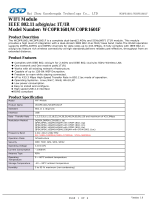12
The Wireless Adapter and Your Health
The wireless adapter, like other radio devices, emits radio frequency electromagnetic energy. The level
of energy emitted by the wireless adapter, however, is less than the electromagnetic energy emitted
by other wireless devices such as mobile phones. The wireless adapter operates within the guidelines
found in radio frequency safety standards and recommendations. These standards and
recommendations reflect the consensus of the scientific community and result from deliberations of
panels and committees of scientists who continually review and interpret the extensive research
literature. In some situation or environments, the use of the wireless adapter may be restricted by the
proprietor of the building or responsible representatives of the applicable organization. Examples of
such situations may include:
Using the wireless adapter on board airplanes, or
Using the wireless adapter in any other environment where the risk of interference with other devices
or services is perceived or identified as being harmful.
If you are uncertain of the policy that applies to the use of wireless adapters in a specific organization
or environment (an airport, for example), you are encouraged to ask for authorization to use the
adapter before you turn it on.
REGULATORY INFORMATION
USA - Federal Communications Commission (FCC)
This wireless adapter is restricted to indoor use due to its operation in the 5.15 to 5.25 and 5.470 to
5.75GHz frequency ranges. No configuration controls are provided for Intel® wireless adapters
allowing any change in the frequency of operations outside the FCC grant of authorization for U.S.
operation according to Part 15.407 of the FCC rules.
Intel® wireless adapters are intended for OEM integrators only.
Intel® wireless adapters cannot be co-located with any other transmitter unless approved by the FCC.
This wireless adapter complies with Part 15 of the FCC Rules. Operation of the device is subject to the
following two conditions:
This device may not cause harmful interference.
This device must accept any interference that may cause undesired operation.
NOTE: The radiated output power of the adapter is far below the FCC radio frequency exposure limits.
Nevertheless, the adapter should be used in such a manner that the potential for human contact
during normal operation is minimized. To avoid the possibility of exceeding the FCC radio frequency
exposure limits, you should keep a distance of at least 20cm between you (or any other person in the
vicinity), or the minimum separation distance as specified by the FCC grant conditions, and the




















